August 24, 2021
I have a confession to make…
I’m a bit of a gum chewer—probably a well-above-average chomping enthusiast compared to the general population.
If you see me on a video, working out, sometimes even recording a podcast, out in public at a speaking event, ambling about a conference, or just walking down the street, chances are, I will be chomping on a piece of gum. Heck, I've been halfway through a meditation session sometimes before I realize I've still got gum in my mouth.
In fact, other than, of course, sitting down to eat a meal or record a podcast, there is rarely a moment when I’m not chewing on some kind of gummy-gooey goodness.
Why am I so obsessed with gum?
On a surface level, I like chewing gum. It tastes good, satiates my appetite, helps me focus, and keeps my breath oh-so-fresh.
From a physiological standpoint, though, chewing gum also has many health benefits, such as strengthening your jaw, increasing salivary enzyme production (my former podcast guest Dean Karnazes talked about how he chomped on Greek mastic gum for much of his run across the Spartan marathon course in Greece, to keep his mouth salivated and appetite satiated), promoting a healthy oral environment, and cleaning your teeth. I've written in the past about how ancient Vikings chomped down on leather straps during battle so they could clench their teeth better and resist pain, and so even my gum chewing during exercise is arguably an ancient bad-ass European intensity tactic, right?
But if you’re not careful with your gum choices, you’re probably doing more harm than good—or perhaps missing out on some of the newer, ultra-healthy gum options out there.
See, most gums in grocery stores are chock-full of artificial sweeteners and flavoring, food coloring, dyes, and even cavity-inducing sugar. Not only are these substances definitely not something anyone in their right mind wants swirling around their precious mouth and draining down the back of their throat, eventually seeping into the bloodstream, but they can also potentially undo many of the health benefits of chewing gum.
However, after years of trying literally every healthy gum I could get my hands on (trust me: people send me new gums to try all the time, since it's now no secret I'm a gum aficionado), I’ve discovered some pretty incredible gum options that are not only free of nasty ingredients but actually contain super useful and unique formulas that can do everything from improving your immune system to boosting your mental focus, and even serving as a unique delivery mechanism for potent anti-aging compounds.
So toss a stick or tablet or wad of your favorite gum into your gaping maw, and enjoy discovering the fascinating history of chewing gum, the science-backed benefits of regular gum chewing, how ingredients in gum can sabotage your health—and, if you stick around (pun intended), I’ll tell you about some of my favorite healthy gums, including some incredibly cutting-edge new brands.
Let’s do this…and oh, one last thing: if you're going to pick up a gum-chewing habit like me, just make sure you dispose of it properly, as the warning video below illustrates the importance of…
The History of Chewing Gum: From Tree Sap to Chiclets to Juicy Fruit
Like many of my articles, I'll start with a good ol’ history lesson. (Because let’s face it, it’s become clear that my sole purpose in life is to create a little army of healthy Trivia Night first place champions.)
All kidding aside, the history of humans and chewing gum is actually pretty interesting.
You may already be familiar with mastic gum, which is the first chewing gum documented in written history and a favorite of the Ancient Greeks. In fact, the very word “mastic” comes from the Greek verb “mastichao,” which means “to chew.” Hippocrates even reportedly used mastic gum as teeth cleaner, breath freshener, and as an aid for digestive issues (and per usual, he was on to something).
Today, we know mastic gum can act as a powerful natural antibacterial and antifungal, even helping to reduce levels of H. Pylori, a bacteria implicated in gastric ulcers. It also reportedly provides antioxidant, anti-inflammatory, hypolipidemic, and anticancer benefits.
However, according to recent archaeological digs, chewing gum appears to be much, much older than Ancient Greece, and has been traced all the way back to Paleolithic times.
In a 2019 paper in Nature Communications titled “Ancient ‘chewing gum' yields insights into people and bacteria of the past,” researchers at the University of Copenhagen successfully extracted a complete human genome from a 5,700-year-old piece of “chewing gum” found in Northern Europe made from birch pitch. Other records date birch chewing gum back to well over 9,000 years ago!
Birch tar, or birch pitch, is a sticky black substance produced by heating the bark of a birch tree. While it’s certainly a useful “glue-like” substance, some theories suggest that—since ancient remains are almost always found with toothmarks—it was also used as an appetite satiating “chewing gum,” a “prehistoric toothbrush,” and perhaps, since it is mildly antiseptic, as relief for toothaches or other mouth pains.
(Interestingly enough, birch contains xylitol, which is now added to many commercial gums as a natural sweetener and to prevent tooth decay.)
But Europeans weren’t the only historical gum-chewers.
The ancient Mayan and Aztec cultures also had their form of gum, called “chicle,” which was made from a natural latex produced by the sapodilla tree. It was traditionally used to quench thirst in hot climates, fight hunger, freshen breath, and clean teeth, and is actually quite similar to the wonderful Chicza gum that I talk about later in this article.
Further up North, indigenous Native Americans preferred spruce tree resin as their gum of choice. It was also used medicinally for respiratory issues and coughs, as a salve for healing deep cuts, wounds, and sores, and as an adhesive and caulking agent.
And this spruce tree resin was exactly what kicked off the massive $19 billion chewing gum industry we all know and love today…
When pioneers settled in North America, they were introduced to spruce gum by the Natives, and like every good capitalistic American story, it was quickly commercialized and sold.
According to the book Chicle: A Story of the Americas—which I highly recommend reading if this little snippet has you chomping at the bit—American chewing gum quickly evolved from spruce tree resin to paraffin wax to imported chicle. In the early 1900s, a candy salesman started coating the chicle resin with a hard candy shell, and the infamous Chiclets were born.
But chewing gum didn’t take off on a worldwide scale until soap industrialist and marketing genius William Wrigley convinced the US Army to add Wrigley’s gum to soldier rations during World War II. This campaign caused a huge surge in demand for sugary, chicle-based gum, putting strain on the Mexican and South American population of sapodilla trees.
In order to keep up with demand, gum producers started creating synthetic substitutes for naturally-derived chicle, usually made from petroleum-based plastics, rubbers, or waxes.
And thus, our bastardized modern-day bubble gum was born: Sweet, chewy plastic. Yum!
The Surprising Health Benefits of Chewing Gum
Once chewing gum became a commercialized product, especially in America, it started to get a bad rap in many other cultures, and gum-chewers were often described as “cows chewing their cud.”
Even today, chewing gum is still prohibited in most schools (I get it, gum under the desk, nasty), and is thought to be sloppy behavior in some countries, like Singapore, where so-called “anti-utopian” chewing gum has been banned since 1992!
What gum haters are clearly not aware of, however, is all the associated health benefits of chewing gum regularly, and the following are a big part of the reason why I'm constantly chomping on healthy gum.
1. Reduces Feelings of Stress
If you’ve ever found yourself in the middle of a stressful workday reaching for a pack of gum like an addict (just me?), you’re at least subconsciously aware of the stress-reducing effects of chewing gum.
In fact, chewing has been described as a “technique of relaxation” since the 1930s.
In a 2012 randomized controlled trial on university students, chewing gum was directly correlated with a reduction in perceived stress (in relation to academic workload). While, admittedly, the bulk of clinical research on gum and stress-reduction is a bit mixed, the most recent review of available studies (2016) in the Journal of Clinical and Translational Research concluded that regular gum chewing is likely associated with reduced stress levels. (The keyword here is “regular,” meaning daily gum chewers may experience the most benefits.)
The stress-reducing effect of gum hasn’t yet been linked to one mechanism, and according to the same review, is likely multifaceted:
“Overall, it would appear that chewing gum attenuates the sensory processing of external stressors and inhibits the propagation of stress-related information in the brain. The neural mechanisms underlying the stress-reducing effects of chewing gum involve the prefrontal cortex which then changes the HPA axis and ANS activity.”
This may also be due to the vagus nerve stimulating effects of chewing gum, which I’ll get to in just a moment.
If you want the stress-relieving benefits of chewing gum, one study showed the harder you chew, the less stress you experience—so if this is the benefit you’re looking for, opt for a more “tough-to-chew” type, such as mastic gum.
2. Boosts Cognitive Performance
Gum chewing has also been shown to improve some measures of cognitive performance, such as working memory, attention, and both executive and intellectual functioning.
A 2015 review of four studies showed that chewing gum during the workday was associated with higher productivity and fewer cognitive problems, and was useful for enhancing worker performance.
However, timing appears to play a factor in whether or not chewing gum may help or hinder your mental performance. A 2011 review in the Journal of Behavioral and Neuroscience Research concluded:
“Chewing gum may increase sustained attention during the later stages of tasks, and prior gum chewing may enhance cognitive performance more generally for a limited time. This may work through chewing gum maintaining alertness during longer periods of attentiveness.”
In other words, if you’ve got a long, grueling day ahead, wait until you’re becoming mentally fatigued to reach for the gum. However, if you want to boost cognition for a shorter amount of time—such as for a test or a big presentation or talk—you may want to chew gum prior to that activity, and then spit it out right before (preferably in a trash can).
3. Promotes Satiety and Reduces Appetite
I don’t know about you…
…but chewing gum is one of the most effective strategies I’ve found to keep myself from mindlessly shoving food down my gaping maw all day. And it turns out the appetite-satiating effects of gum are backed up by research.
One randomized controlled trial published in the journal Physiology and Behavior analyzed the effects of gum chewing as a strategy to enhance lunch satiety and reduce afternoon snack intake. Compared to controls, gum-chewing resulted in significant suppression of hunger, desire to eat, and prospective consumption, and was shown to be a potentially effective way to reduce high carbohydrate snack intake in the afternoon.
Another study in Appetite found similar results, confirming that chewing gum for up to 45 minutes after lunch reduces subsequent snack intake, repressed the return of hunger following lunch, and reduced cravings for sweet and salty snacks.
Researchers from the Tokyo Medical and Dental University conducted a study in 2018 that looked at the effects of chewing gum on appetite and overall interest in food. They found that even sugarless, tasteless gum was able to reduce subjective appetite and attentional bias to food and therefore may prevent impulsive eating.
4. Strengthens Your Jaw Muscles
If you want to have, as I like to say, “a manly, manly jawline,” add regular gum chewing to your beauty regimen.
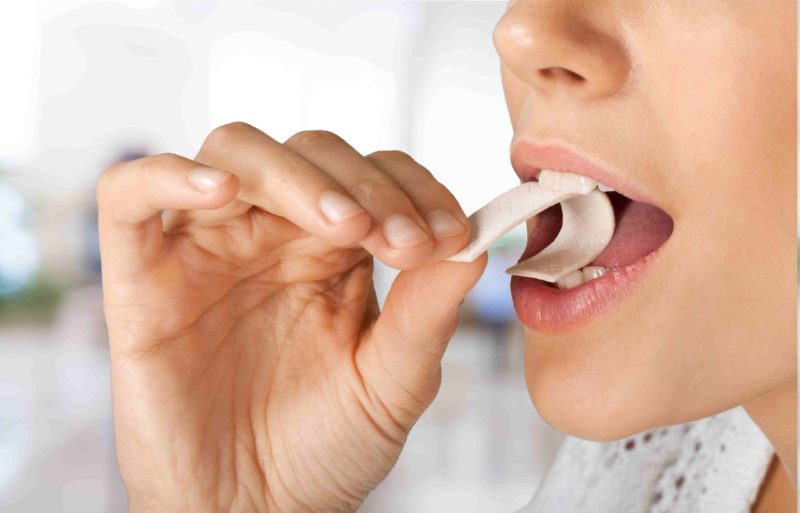 Alright, to be honest, there’s no conclusive evidence that chewing gum gives you a male-modelesque jawline…
Alright, to be honest, there’s no conclusive evidence that chewing gum gives you a male-modelesque jawline…
However, there is indeed research showing that it can strengthen the muscles around your jaw, improving their function. And as discussed in one of my favorite books on natural beauty and symmetry, “Deep Nutrition” by Cate Shanahan: form implies function. In other words, we can hypothesize that a well-exercised jawline = a more functional jawline = a more attractive, symmetrical jawline.
According to a 2019 study published in the Journal of Dental Sciences, gum-chewing training strengthened muscles in the jaw, tongue, lips, and cheeks involved in chewing and swallowing. Another study from 2018 showed that chewing gum for 5 minutes twice a day, for four weeks, led to stronger masticatory muscles and improved bite force.
Interestingly though, in this study, the best results were noted in subjects with “dolicho facial” structures—longer, narrow faces and less defined jaws. In other words, those who have skinner, less defined jawlines may actually get the most jaw-chiseling benefits of chewing gum.
However, I would be remiss if I didn’t note that excessively chewing gum can also lead to problems with jaw alignment, tension headaches, or lead to temporomandibular joint disorders (TMJ). If you start getting any of these issues, you might want to take it easy on the gum for a while. But I can say that, as a person who basically chews gum all day long, I’ve never had these problems, so I think it may have to do more with the quality of gum being chewed.
5. Activates Your Vagus Nerve
The vagus nerve is your longest cranial nerve and serves as the major communication system, or “information highway,” between your brain and the rest of your body and other organs.
As such, having good “vagal nerve tone”—or optimal functioning of your vagus nerve—is vital for gut health and proper digestion, hormone production and balance, thyroid health, kidneys, blood pressure regulation, heart rate, fluid balance, and much, much more.
There are a number of substances and activities that can “activate” your vagus nerve and improve vagal tone—including supplements and biohacking devices like the NuCalm—many of which I covered in a podcast with Joseph Cohen of SelfHacked.com, titled “32 Ways to Stimulate Your Vagus Nerve, Fine-Tune Your Nervous System & Self-Hack Your Hormones.”
However, one of the easiest ways to activate your vagus nerve very well might be chewing gum. Chewing gum has been shown to activate the release of cholecystokinin (CCK), a gut hormone that can directly activate vagal impulses in the brain, as well as reduce appetite. A randomized controlled clinical trial published in the British Journal of Surgery invested the effects of chewing gum on post-colorectal surgery recovery. Compared to controls, chewing gum decreased gastrointestinal inflammation, reduced post-surgery complications, and enhanced recovery times. According to the researchers, the results were likely associated with gum chewing’s ability to activate the vagus nerve and promote healing.
6. Can Improve GI Function
The vagus nerve is also well known as a “modulator of the Brain-Gut Axis,” as it connects the brain to the gastrointestinal tract, transmitting signals from the gut to the brain, and vice versa.
The vagus nerve also helps to activate the parasympathetic nervous system (PNS) activation, increasing your body’s ability to get into “rest and digest” mode.
Additionally, as mentioned, chewing gum stimulates the release of CCK, which regulates a number of gastrointestinal functions like facilitating digestion, producing gastric acid, releasing pancreatic fluid, and contracting the gallbladder.
In a 2016 review of randomized controlled trials, researchers assessed whether or not chewing gum was effective for improving the early recovery of bowel function in mothers who had just delivered babies via C-section. They reported that “gum-chewing in the first 24 hours after a C-section was a well-tolerated, low-cost, safe, and easy intervention that enhances early recovery of bowel function and improves maternal comfort.”
Chewing gum has also been shown to be a potential therapy for reducing gastroesophageal reflux (acid reflux) after meals. Not only is acid reflux painful and uncomfortable, the regurgitated stomach acid that enters the mouth can also cause dental erosion. A randomized controlled trial from 2015 showed that chewing sugar-free gum for 30 minutes after a meal was effective for reducing acidic postprandial esophageal reflux. Another clinical trial from 2001 found that chewing gum was useful for antireflux therapy for patients with laryngopharyngeal reflux (an uncomfortable condition in which stomach acid travels up the esophagus to the throat, causing a sore throat and an irritated larynx).
Therefore, chewing healthy gum before a meal may help to prepare the digestive system and improve overall digestion. Chewing gum after a meal can reduce the chances of postprandial issues like acid reflux.
The caveat here is that, since chewing gum may indeed stimulate digestive processes and activate the GI tract, those with sensitive inflammatory gut conditions like colitis or stomach ulcers may want to minimize gum chewing, or perhaps limit it to before or after meals.
7. Increases Saliva Production, Promotes a Healthy Oral Environment, and Reduces Cavities*
Simply chewing unsweetened, unflavored gum has been shown to stimulate salivary flow rate by 10-12 times.
The question is, what’s spit got to do with it?
Adequate saliva is incredibly important for the health of your mouth. The enzymes in saliva help maintain a healthy oral microbiome, decrease the amount of cavity-causing bacteria, clean and protect teeth, prevent dental erosion by buffering acids, and pre-digest starchy foods. So by chewing gum and stimulating saliva production, you’re helping to clean your teeth, strengthen enamel, and prevent cavities. Chewing gum before and after meals is going to result in the best benefits for saliva production, and therefore oral health.
Chewing gum before eating can help stimulate the production of salivary enzymes that will help you better digest your meal.
By chewing gum after eating, the increased salivary flow can help neutralize and clear enamel-destroying acids that are produced when food is broken down by oral bacteria. This may be why, as shown in clinical trials, people who chew sugarless gum after meals have fewer cavities.
*BIG CAVEAT: Obviously, if you’re chewing gum that’s sweetened with sugar or contains added preservatives, you’re not going to get these same benefits and will probably find yourself with even more cavities. I highly suggest choosing a sugar-free gum that uses a natural sweetener like xylitol, which can increase salivary flow and pH, reduce levels of bad bacteria in the mouth, decrease plaque, reduce gingival inflammation, promote mineralization, and reduce dental cavities.
More on those healthier options in just a minute…
So there you have it: Masticators for the win (heh).
However, it bears being discussed that the quality of your gum is the biggest factor in whether you experience these benefits, or are, instead, chewing on sugary plastic that’s giving you headaches, destroying the health of your teeth, oral microbiome, and perhaps even your gut health.
What’s Really In Your Gum?
The sad fact is, today’s modern gum—Orbit, Wrigley’s, Extra, and yes, especially that cool colorful Zebra gum with stick-on tattoos—is nothing like the natural antibacterial, anti-inflammatory, pain-relieving “gum” of our ancestors.
Instead, most chewing gum today consists of a base mixture of petroleum or plastic-based gums, which is then combined with softeners, preservatives, sweeteners, colors, and flavorings.
While we have some evidence that most of these ingredients are bad news for our health, such as artificial sweeteners, the truth is, the FDA still claims most of them are “safe for human consumption”—and thus, they continue to be used. Regardless, these question marks are concerning, considering the fact that every year, trillions of sticks of gum are produced, and the average American alone chews nearly 300 pieces.
Even if you don’t swallow gum (which you shouldn’t, because it sticks in your digestive system for seven years, remember?), the ingredients can still make their way into your bloodstream through the mucous membranes of your mouth.
So, here’s what you’ll find in most gums today, and why you should take caution when sticking just any old chewing gum in your precious pie hole.
1. Gum Base
Instead of simple tree sap, these days, the base of modern gum is usually a combination of resin, wax, and elastomer—all of which, depending on the gum, can either be natural or synthetically derived.
Common gum base ingredients are usually a combination of:
- Butadiene-styrene rubber (a main ingredient in car tires)
- Isobutylene-isoprene copolymer (a synthetic rubber often used in rubber gloves)
- Paraffin/petroleum wax (made from saturated hydrocarbons, sometimes used in candles and electrical insulation)
- Polyethylene (most common plastic in use today)
- Polyisobutylene (used to make the inner tubes of tires)
- Polyvinyl acetate (known as “white glue”)
Not sure about you, but I’d rather not be chewing on inner tubes or glue…
The unfortunate truth is, many of these synthetic ingredients can be hidden under the catch-all term “gum base” on a label. So in most cases, unless the company discloses what their gum base is made out of, you may not actually know what you’re chewing on!
2. Preservatives
Just take a second to think about how long most gum lasts…
You can have the same pack for months on end, tucked away in an old pair of jeans, and it still tastes as delicious and chewy as the day you bought it (which was probably still several months after it was made, depending on how long it sat on the grocery store shelf).
Almost all chewing gum contains some kind of preservative that extends its shelf life, the most popular of which are the organic compounds butylated hydroxytoluene (BHT) or butylated hydroxyanisole (BHA).
According to the Report on Carcinogens, BHA is “reasonably anticipated to be a human carcinogen based on sufficient evidence of carcinogenicity from studies in experimental animals.” Yikes.
The use of BHT is a little more up in the air, as studies show mixed results. However, some animal studies concluded that high doses can cause cancer, specifically in the thyroid.
3. Artificial Colors
Think about a gumball machine…
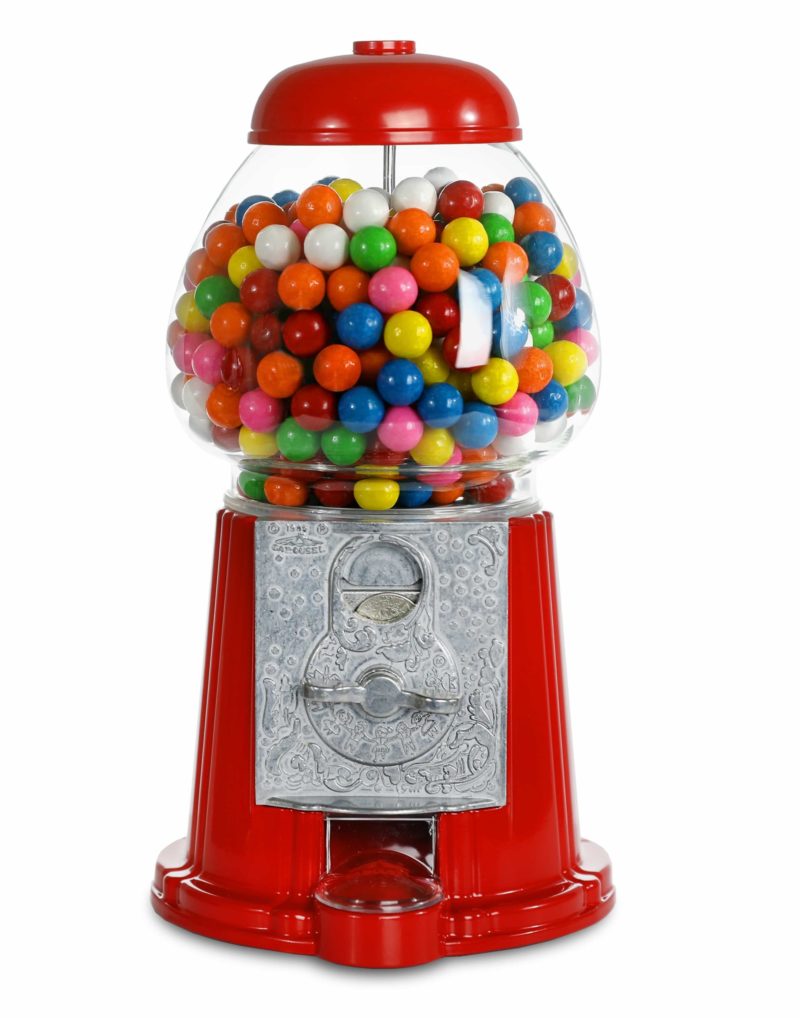 What comes to mind?
What comes to mind?
For me, it's the rainbow of shiny colors…what kid can resist? Gums on the supermarket shelves may not necessarily be covered in that hard candy shell, but the variety of colors is still impressive. That is if you're not concerned about the potential negative health consequences of artificial colors and dyes.
While many commercial gums are white—intended to be associated with a fresh mouth and bright white teeth—there are, believe it or not, white dyes that can be added to gum to get that “healthy” (not so much) color. And of course, you're always going to find a number of Pepto-Bismol-colored gums. Why are there so many pink gums out there, anyway? Well, we can thank Walter E. Diemer, an accountant at the Fleer Chewing Gum Company in Philadelphia, for that. He spent his spare time inventing new recipes and back then, in the 1920s, red dye (diluted to pink) was the only color in the shop that would mask the unappealing dingy gray that resulted from his method.
Beyond white and pink, you can find nearly every color in commercial chewing gums, and even multiple colors (dyes) in a single package, such as the aforementioned Fruit Stripe gum (trust me, there's no fruit in there), with five bright zebra-print colors and the wrappers doubling as temporary tattoos.
4. Flavorings
How do you think most gums get that refreshing, minty flavor?
Or how about otherworldly bubblegum goodness?
It’s usually due to the use of a synthetic flavoring agent, the most common of which is citric acid. Acid and teeth, not a good combo, right? Right.
According to The American Dental Association, chewing gum that contains acids for flavoring (e.g., citric acid) lowers the pH of the gum which can cause enamel demineralization and erosion, and lead to cavity formation.
5. Sweeteners
Once chewing gum became a commercialized product, sugar was quickly added to increase palatability and make for a more enjoyable experience.
In other words, chewing gum started looking more and more like candy.
However, as opposed to being sweetened with sugar, most gum you’ll find today is “sugar-free” (thanks to a dentist from the 1950s, Dr. Bruno Petrulis, who wanted to find an alternative to the cavity-causing sugary chewing gum).
While sugar-free gum is definitely easier on your pearly whites, the truth is, depending on what type of sweetener is used, it may be causing you other problems. Most often, sugar-free gums are sweetened with artificial sweeteners, the most common being aspartame, sucralose, or acesulfame potassium (Ace-K).
Now, I’ll spare you the long list of issues with artificial sweeteners and why you should avoid them, as I’ve covered this topic in many places previously. But if you regularly chew sugar-free, artificially-sweetened gum and experience digestive issues, headaches, or blood sugar dysregulation, switching to a gum that uses xylitol could make a huge difference. However, consuming sugar alcohols—including xylitol, erythritol, sorbitol, and others—can be problematic if you have SIBO (small intestinal bacterial overgrowth), as they can fuel the excess bacteria residing in your small intestine, which can trigger a bout of symptoms.
In summary, most modern gum ingredients are far, far from natural tree resin, and usually look something like this:
“Gum Base (polyisobutylene, polyvinyl acetate, styrene-butadiene rubber, butyl rubber, paraffin, microcrystalline wax, hydrogenated vegetable oils, lecithin), Aspartame, Acesulfame K, Sucralose, Glycerin, Sorbitol, Maltitol, Xylitol, High Fructose Corn Syrup, Artificial Flavors, Artificial Colors, Titanium Dioxide, Calcium Casein Peptone, Butylated Hydroxyanisole (BHA), BHT”
Not exactly what I would call a health-promoting product.
But enough bursting your bubble (heh). Let’s get on to the gums that actually are good for you—and so much more.
The Top 7 Healthy Gums for Nootropic Effects, Weight Loss, Immunity & More
Admittedly, my obsession with finding the healthiest gum options has made me a bit of a connoisseur. Over the past few years, I’ve likely chewed every “healthy” gum on the face of the planet, and have developed quite the arsenal of go-to chewing gums depending on what situation I’m in.
Boarding a germ-infested airplane? I'll often pop a piece of natural immunity-boosting gum.
Settling in for a long day of writing or a late night dinner? I’ll chomp on some cognitive-boosting nicotine gum.
Need a little energy boost before a workout or a pick-me-up when there's no time for coffee? Caffeine-enriched gum does the trick.
So, without further “a-chew” (too far?), in no particular order, here are some of the top healthy gums for everything from performance-enhancing, appetite-satiating, and even longevity-boosting.
But first, before jumping into some more sophisticated options, in the case that you do most of your gum-grabbing off grocery store shelves, here are some general guidelines to follow when finding healthy chewing gum.
In short, a “healthy” gum will have a natural base (such as from resin or chicle), be sweetened with xylitol or stevia, and be flavored with natural essential oils.
At the very least, it should be free of:
- Artificial sweeteners like Aspartame or Acesulfame-K
- Petroleum-based gum bases
- Food dyes or colorings
- Preservatives like BHA/BHT
- Sugar alcohols if you have gas or bloating issues
Relatively decent (though, admittedly, not perfect) brands you can often find and grab in a pinch at any ol’ natural grocery store include:
- Spry
- Pur
- Simply Gum (clean ingredients although sweetened with cane sugar, so chew sparingly)
While these gums will certainly do the trick in terms of keeping your breath fresh, teeth clean, and appetite satiated, if you’re anything like me, you probably want to get the most bang-for-your-bubblegum.
In that case, here are some of my favorite choices that go above and beyond just being a chunk of gooey goodness, and actually provide additional health benefits, too.
1. Mastic Gum: Stomach Soother
If you’re a gum minimalist (or, perhaps more accurately, masochist) you might enjoy chomping on some mastic gum, which I mentioned earlier was first introduced to me on a podcast with ultra-marathoning legend Dean Karnazes.
Yep, this is indeed the same “chewing gum” used by the ancient Greeks. To this day, it continues to be harvested from the mastic tree native to the island of Chios.
 Mastic gum has a number of medicinal properties, including:
Mastic gum has a number of medicinal properties, including:
- Helping with indigestion
- Preventing cavities
- Reducing symptoms from stomach ulcers
- Soothing inflammatory bowel disease
- Improving cholesterol and blood sugar levels
Personally, I’ve chewed on mastic gum as part of a gut healing protocol to get rid of bacterial overgrowth, as it’s reportedly able to—similarly to oregano oil—break down the bacterial cell wall of H. Pylori.
Now, word to the wise: mastic gum is not for the faint of heart (or jaw). It’s nothing like the soft, sugary bubblegum most of us are used to, and the experience is more akin to chewing on hard, cedar-flavored wax. So in addition to helping the occasional stomach issue, it can also be a good stress reliever because of how hard you have to chew it (caution: chew slowly, or your jaw will be very, very sore).
In other words, if you get occasional digestive distress after meals, are dealing with a bacterial overgrowth such as H. Pylori, want to strengthen your jaw, or simply have a lot of pent up anger or stress you need to take out on your gum, trying chomping on some mastic gum.
I often use this one from Krinos, as it’s pure Greek mastic resin, nothing else.
2. Chicza Gum: Natural Mayan Chewing Gum
 Another modern gum that closely resembles that of our ancestors is Chicza Gum, a natural, 100% organic, biodegradable, sustainable chewing gum made from the sap of Chicle trees from the Mayan rainforest.
Another modern gum that closely resembles that of our ancestors is Chicza Gum, a natural, 100% organic, biodegradable, sustainable chewing gum made from the sap of Chicle trees from the Mayan rainforest.
Chicza Gum is made with incredibly simple ingredients: Powdered organic evaporated cane juice, organic gum base (from chicle), organic glucose, organic agave syrup, and organic flavor.
(Yes, it does contain small amounts of sugar, so if you’re worried about cavities you may want to chew it sparingly.)
I’ve been chewing Chicza Gum for a few months now, and I’ll say it is quite delicious and satisfying. Plus, the fact that it’s completely biodegradable and I can toss it out my car window without feeling bad is really a bonus (joking!). Since I like a “larger gum wad” in my mouth, my current gum strategy is to pop a piece of nicotine or caffeine or immunity or any of these other gums, then combine it with a piece of Chicza. I'm such a gum glutton, aren't I?
3. Slique Gum: Weight Loss Support
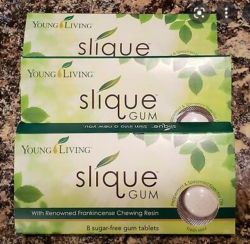 Slique Gum, as the name implies, is a natural gum designed to keep you sleek and slender…
Slique Gum, as the name implies, is a natural gum designed to keep you sleek and slender…
…using a unique blend of essential oils and resins that help to curb appetite and prevent excess snacking.
The main ingredient in Slique Gum is Frankincense resin, which was actually chewed by ancient Middle Eastern travelers during long journeys to satisfy cravings and keep them from getting hungry. The best part is Slique Gum is incredibly tasty, which is quite shocking considering it contains no artificial sweeteners or flavors, and is simply flavored with xylitol, peppermint essential oil, and spearmint essential oil.
Pick some Slique Gum up here under “YL Exclusive Products.”
4. Lucy Gum: Cognitive Stimulant (Plus a Homemade Version)
One of my go-to gums for a long, grueling day of writing and other work is nicotine gum.
Why?
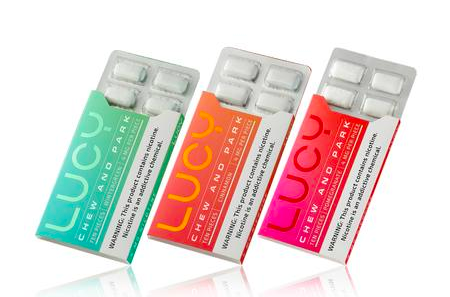 Nicotine is a potent cognitive stimulant and has been shown to improve motor skills, attention capacity, memory, and reaction time, and may even have neuroprotective and anti-inflammatory effects, serving as a potential therapeutic for Parkinson’s Disease (read more about the benefits of nicotine in this Self-Hacked article).
Nicotine is a potent cognitive stimulant and has been shown to improve motor skills, attention capacity, memory, and reaction time, and may even have neuroprotective and anti-inflammatory effects, serving as a potential therapeutic for Parkinson’s Disease (read more about the benefits of nicotine in this Self-Hacked article).
However, most nicotine gum is full of artificial sweeteners, chemicals, and other nasties, so for the most part, I usually avoided it and instead opted for nicotine toothpicks.
That is, until I found Lucy Gum—a much cleaner, sugar-free, and aspartame-free nicotine gum, with 4mg of nicotine per serving. It’s a huge improvement on the texture and taste of existing options and is, unlike Nicorette, actually enjoyable to chew. I often keep a pack of Lucy Gum in my home office for those days I know I’m going to need a little extra in terms of my ability to focus, recall, or be highly productive (use code BEN20 to save 20% at Lucy.com).
On the other hand, if you’re more of a DIY-er, here’s my very own recipe for making your own nicotine gum at home!
DIY Nicotine Gum Recipe
Ingredients:
- Gum base (I ordered NB-CN-040, which comes as a giant gum “brick”)
- Omica Organics stevia
- Pure pharmaceutical-grade liquid nicotine
- Strawberry oil extract and vanilla extract (or any other flavorings of your choosing)
Additional Supplies:
- Non-GMO cornstarch
- Wax paper
- Rolling pin
- Container and utensils (that you don't mind potentially getting ruined)
- A pot filled with water
Instructions:
- Melt the gum base: Use a double boiler to slowly melt the gum base. The gum base is very sticky and has the potential to ruin anything it comes in contact with (consider using an old food jar for the melting process.) Put 1/4 cup of the gum base in a jar, bring the water in your pot to a boil, then put the jar in the water. After about 20 minutes the gum base begins to melt and gets very sticky.
- Knead the gum: Once the gum base is nice and gooey, take it off the flame, and scoop it onto a cornstarch-coated surface. Knead the gum until it has a taffy-like consistency. If it sticks to your hands too much, add more cornstarch.
- Add flavorings: Using a dropper or small teaspoon, slowly add a small amount of your desired flavoring. Taste test throughout this process to see how much flavoring is enough.
- Flattening and cutting: Using a rolling pin, flatten the gum out to your desired thickness, then cut into squares.
- Packaging: After you cut it into squares, I recommend folding it up into small wax paper squares, or just keeping it in a glass or stainless steel container in your pantry.
It should be noted that nicotine can be addictive and withdrawals are pretty uncomfortable. So I admittedly chew Lucy Gum very selectively these days and use a number of “hacks” to mitigate any nicotine dependence.
5. Neuro Gum: Nootropic
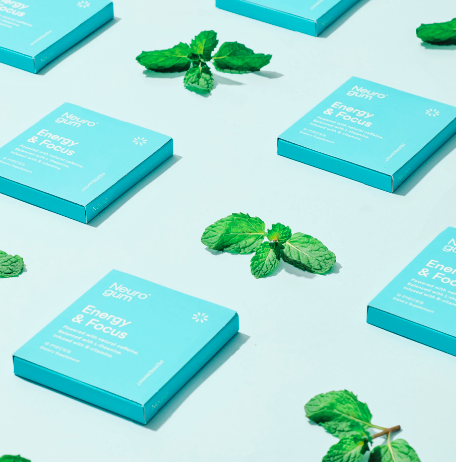 If you’re not a fan of nicotine, but still want a healthy gum that can do more for your mental game, Neuro Gum—a favorite of the Silicon Valley tech-heads—might be for you.
If you’re not a fan of nicotine, but still want a healthy gum that can do more for your mental game, Neuro Gum—a favorite of the Silicon Valley tech-heads—might be for you.
Neuro Gum contains natural “nootropics,” ingredients that are proven to enhance cognitive performance or induce a certain desired mental state (you can learn more about nootropics in my article “Limitless & Lucy – Your Ultimate, Done-For-You Guide To Nootropics, Smart Drugs & Psychedelics.” )
For instance, Neuro Gum’s “Energy & Focus” blend contains energy-enhancing B Vitamins and 40 mg of caffeine, along with 60 mg of L-Theanine to decrease potential jitteriness. They also have mints for “Calm & Clarity” with added GABA, Vitamin D3, and L-Theanine—which, when combined with their gum, results in a pretty unique focused-yet-calm cognitive experience.
And of course, all Neuro Gum is free of Aspartame, sugar, and flavored with natural peppermint or cinnamon.
6. PEAK Gum: Longevity and Anti-Aging
 Over the past few years, I've talked extensively about the potent longevity, anti-aging, and numerous other health benefits of the coenzyme NAD+ (nicotinamide adenine dinucleotide):
Over the past few years, I've talked extensively about the potent longevity, anti-aging, and numerous other health benefits of the coenzyme NAD+ (nicotinamide adenine dinucleotide):
- The Next Big Anti-Aging Drug: Everything You Need To Know About “NAD”.
- The New Darling Supplement Of The Anti-Aging Industry (& The Truth About Whether It Actually Works).
- How To Keep Your NAD Levels Elevated (Without IVs) For Staving Off Aging, Cellular Health, Full Body Repair & Much More.
In fact, I’m such a proponent of increasing NAD+ levels that I’ve been self-administering injections of it for a while now. And while regularly sticking myself with a needle sure is fun, I’ve been keeping my eyes open for a more novel (and more enjoyable) delivery mechanism of NAD+…
…and now, thanks to my friend, anti-aging expert, and previous podcast guest Craig Koniver, MD, it finally exists.
It’s called PEAK Gum.
PEAK Gum is the first NAD+ gum (25mg) on the market, and also contains added cognitive benefits from caffeine (25mg) and CBD (10mg).
So if you’re looking for a healthy gum that can not only help you feel more energized and focused but may even help you age more gracefully—and I dare I say, possibly live longer—you’ll absolutely want to check out PEAK Gum (and save 10% off your order with code Peak10).
7. Mighty Gum: Immune Boosting
If I had to choose a favorite immune-supporting gum out of this list, it would very much be Mighty Gum.
Besides being absolutely delicious, 100% natural, and free of sugar or artificial sweeteners, Mighty Gum contains so many added nutrients it essentially doubles as a multi-vitamin.
Their Immunity Gum contains vitamins A, B, C, D, and E, zinc, as well as other botanicals and adaptogens like:
- Ashwagandha: An adaptogen that helps your body manage stress
- Astragalus: Builds and balances the immune system
- Elderberry: Supports the inflammatory response
- Reishi Mushroom: Supports a healthy and robust immune response
Plus, the texture is perfect for jaw-strengthening and salivary production, and it maintains its flavor better than other natural gums (fun fact: it turns from purple to white once you’ve chewed out all the active ingredients, neat!).
I must say, this stuff is the definition of “guilt-free” gum. It comes in a mouth-watering berry flavor that I absolutely have been digging and chewing a ton of, particularly during travel, when on airplanes, in public, crowded spaces, etc. and you can get it here.
Summary
I hope this article gave you something to “chew” on (OK, last pun, I promise).
While the act often gets demonized, the truth is, humans have been “chewing gum” in some form or another for thousands of years.
In fact, scientific research shows chewing gum is remarkably good for your health and has a number of benefits, including:
- Helping you feel less stressed
- Boosting your cognitive performance, focus, attention, memory, and productivity
- Supporting weight loss by preventing you from snacking or over-eating
- Strengthening the muscles in and around your jaw (and research pending, may turn you into a GQ male model)
- Activating your vagus nerve
- Helping you digest your food better and reduce acid reflux
- Promoting a healthier mouth and cleaner, cavity-free teeth
However, like many things, the benefits you experience greatly depend on the quality of gum you’re chewing. Most modern gum is chock-full of petrochemicals, plastics, hydrogenated oils, artificial sweeteners, artificial flavorings, and dyes.
Not sure about you, but I definitely don’t want to be chewing on sugary plastic all day.
Luckily, today there are so many options for healthy gums, including those that even have added benefits. Some of my favorites include:
- Mastic Gum for digestive issues and jaw strengthening
- Chicza Gum as a natural, organic option
- Slique Gum for satiating cravings (use code 606426 to save)
- Lucy Gum for a cognitive boost from nicotine (use code BEN20 to save 20%)
- Neuro Gum as a potent nootropic
- PEAK Gum for the potent anti-aging benefits of NAD+, as well as CBD and caffeine (save 10% with code Peak10)
- Mighty Gum as a delicious immune-boosting, vitamin-rich gum
In summary, gum can be good for you, but only if you’re “chew-sy” about it. ;)
What’s your favorite healthy gum to chew? Do you know of any other good-for-you options I should try? Have you tried any of these? Leave your questions, comments and feedback below. I read them all!

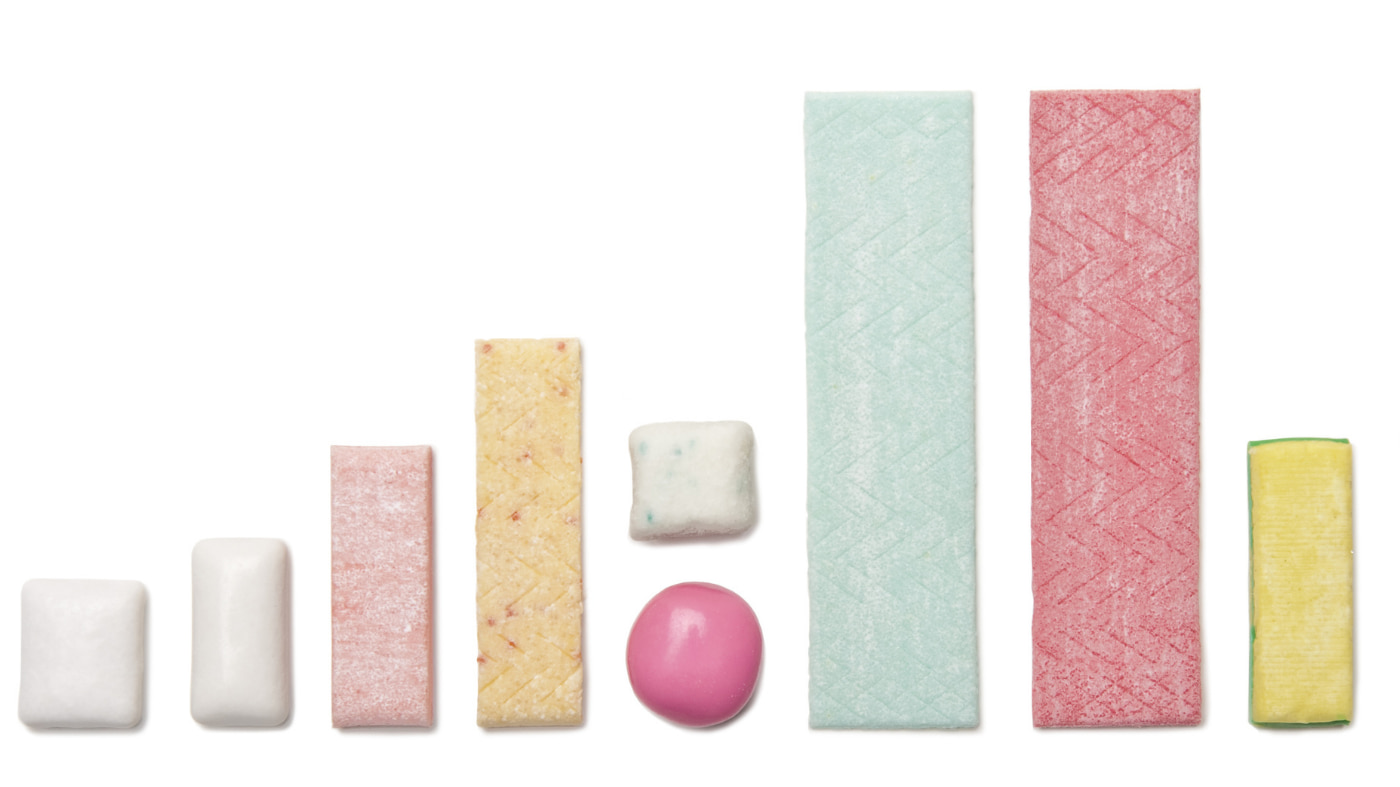





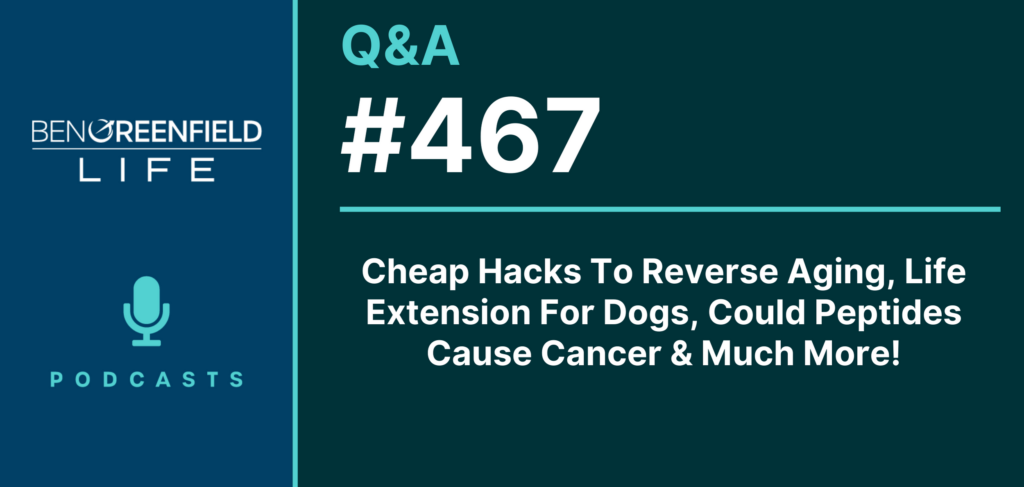






It’s easy to look at gum chewing as nothing more than a problematic habit. However, the deeper that you get into the topic, such as how you’ve done here, the more you realize just how beneficial it can be. Great information here!
I ordered the Mastic and Chicza gums, buuut I must be the only one wanting to order Mighty gum because no one else has mentioned this…. they are out of stock, and have been since January of this year.
I understand full well that you can’t ask them to make more, maybe ever. That is a remarkably long time, you should certainly update your article.
I would really like some though, so if you do reach out to them please let me know the results.
I’m considering the PEAK gum but I’m 6 months pregnant. The internet doesn’t provide much support on NAD while pregnant. I know you’re not a medical provider but in your opinion/knowledge on NAD does it theoretically seem safe for pregnant women later in term? It’s not like its a high dosage in the gum but still curious to get your thoughts.
As I have a condition that reduces moisture in the body, it is recommended that I chew gum regularly to avoid dry mouth causing bad teeth so choosing a healthy chewing gum is important. Probably following the recipe could be more natural alternative than buying the commercial ones which contain chemicals.
Hi Ben
Do you know if the Peak Gum would ship to Australia?
I tried the contact page to email them but it didnt work.
Try calling them at +1 843 767 7650 or the email: [email protected]
Hey Ben,
I love all your content and have become an avid fan and follower. I read this article with great interest.
I’m trying to find some slique gum but am struggling with locating it here in the UK or any that could be delivered to the UK. Do you have a good substitute for this type of gum or do you know anywhere I can get my hands on it!
Thank you and please keep all this good s**t coming! 🙌🙏
You can make your own nicotine gum for pennies on the dollar no matter where you are in the world! https://www.instagram.com/p/CEK2EdUsWDM/?hl=en
Dear Ben, I truly love your content and enjoy reading and listening to you, and I trust your opinion on many things. Though one thing I would love to hear your opinion on is “Natural Flavors” found in many of the products that you promote. I’ve read in several places, mostly in articles and posts from the very well known and respected Food Babe Vani Hari, that “Natural Flavors” are nothing more than a regulatory and marketing work around for using artificial flavorings in the food industry. Surely you are aware of this and have pondered it yourself. If this is true, and if avoiding artificial fake ingredients that are known to cause harm to the human body is the goal, then why promote products that contain these ingredients? Products like Zevia, these different brands of gum, Magic Spoon Cereal, and many others that are considered to be “free of artificial sweeteners and flavors” clearly are not, if what is said about natural flavors is true. Your thoughts?
We talked about this a little bit before in a previous podcast but according to the US Code of Federal Regulations, a natural flavor is the essential oil, essence, or extracted protein hydrosylate, distillate, or any product of roasting, heating, or enzymolysis which contains the flavoring consistence derived from a spice fruit or fruit juice, vegetable or vegetable juice, edible yeast, herb, bark, bud, root, leaf or similar plant material, meat, sea food, poultry, eggs, dairy products or fermentation products thereof, whose significant function in food is flavoring rather than nutrition, and of course, we would all prefer to see natural flavors on the label because we believe that those are somehow more healthful but really, the distinction between the artificial and the natural flavors is pretty arbitrary and it’s more based on the way that the flavor was extracted, more than what the actual flavor contains. So for example, you can take like an omen flavor which is derived from an peach and apricot pits and it’s basically a chemical benzaldehyde and it contains traces of cyanide which is actually a deadly poison. You have to eat a lot of omens to actually get that or drink a lot of omen oil to actually get toxicity from it but it is really an artificial flavor that can be marketed as a completely natural product because it’s been extracted from peach and apricot pits and, we could take this to the ins degree and begin to look at natural flavors and just about everything that we consume, and assume that they’re all just really synthetic chemicals that have been masked. But what it comes down to is simply moderating the amount of foods that you eat, that contain any type of added flavoring or preservative or chemical. If you eat something in it’s natural, holistic state, then this is a concern that you’re not really going to have anyways and the way that I like to think about it is this: if you say you take an apple, and you buy an apple from the gas station and then you go buy an apple from a natural, organic health food store; if you were to take the logic applied to natural and artificial flavorings, then we would say that the apple that you bought from the gas station is artificial because its source is not a fruit stand or grocery store and the apple that you buy from the organic health food store is natural because it does come from a fruit stand or a health food store, and that’s just ludicrous. What it comes down to is that we, as consumers, really can’t control too much of these food politics with anything other than our voting and our lobbying but when we’re grabbing something off a shelf and glancing at the back of it to see whether it says “natural flavoring” versus, if it says “artificial flavoring”, there’s not going to really be a way for us to really truly know how healthy that source is, from which the natural and the artificial flavoring has been derived. And I simply stand by avoiding, for the most part, sucralose, acesulfame potassium and aspartame, and then trying to mostly eat things that don’t have labels on them in the 1st place and if you do that, this is a worry that is not going to need to be at the fore front of your mind.
Hi Paul! Sorry about that. Please try again with code BEN20
Hi Ben, the BEN10 code doesn’t work for Lucy gum
Sorry about that Tim. Please try code BEN20 instead. Thanks!
I’d like to know if there is any where to buy these gums in the UK.
Thanks Ben. Now I am going to try to find a place to purchase these gums. I
have been chewing P’u’r gum with xylitol. Not as good as you’re picks I am sure.
Hi Ben,
Question. Will chewing these gums break a fast?
Hi Pamela! I’m constantly chewing gum. Whether it’s for staving off appetite cravings, cleaning my teeth, increasing salivary enzyme production or strengthening my jawline, I’m almost always chomping on some kind of gummy-gooey goodness (and no, gum doesn’t “break your fast”).
Hi Ben,
thanks for answering this question (i was about just to post the same). As overengeneering it might be. When its about to maximize the benefits of your fasting window, which of the above mentioned gums you would choose :)
Thanks for the great weekly input!
Much appreciated!
Daniel
You're welcome Daniel. Check out the Kion Fasting eBook and the collection of expert videos: https://getkion.com/fasting
Does chewing any of those gums recommended ,raise insulin levels?I find that chewing mastic gum helps me through 20 hours intermittent fasting.